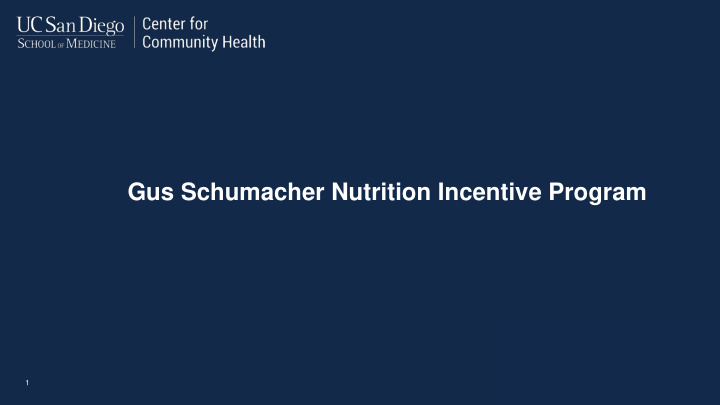



Gus Schumacher Nutrition Incentive Program 1
Presentation Goals & Objectives 2
Legislation and Funding 2008 Farm Bill authorized funding to determine if nutrition incentives provided to SNAP recipients increases the purchase and consumption of fruits and vegetables. 3
Legislation and Funding • 2014 Farm Bill designated $100 million for the Food Insecurity Nutrition Incentive (FINI) Program. • 2018 Farm Bill renames the program in honor of USDA Under Secretary of Agriculture Gus Schumacher and designated $250 million in funding. 4
Technical Assistance, Innovation, Evaluation & Reporting 5
Gus Schumacher Nutrition Incentive Program 6
Gus Schumacher Nutrition Incentive Program Approximately 2,600 retailers across 38 States and the District of Columbia provide Nutrition Incentive Programs, including: • 1,619 farmers markets • 440 grocery stores • 342 direct marketing farmers • 104 mobile markets • 100 community-supported agriculture programs • Families • Supporting Farmers and Retailers • Local Economies 7
Societal and Economic Impact In California, Nutrition Incentive Programs aid approximately 1,000 specialty crop farmers and support over 70,000 CalFresh recipients. Nutrition incentives for fruits and vegetables is a • Empowering Families common sense, proven model for local economic development and promotes a more nutritious diet • Supporting Farmers among safety net beneficiaries. and Retailers CalFresh clients in California have a buying • Lifting-up Local power of $7.8 billion. Nutrition Incentive Economies programs drive more of this money toward local farmers and small businesses. 8
Southern California Nutrition Incentive Program ¡Más Fresco! More Fresh Program Innovative nutrition incentive program utilizing point-of-sale technologies in a large-scale retail setting Kyung Rhee, MD, MSc, MA 1,2 , Joe Prickitt, MS, RD 2 , Sarah Hiller-Venegas, MPIA 1 , Blanca Meléndez, MA 2 , Kate Edra, MPH, CHES 2 , Todd Gilmer, PhD 1 and Michelle Murphy Zive, PhD, MS, RD 2 1 UC San Diego School of Medicine 2 UC San Diego Center for Community Health 9
UC San Diego Center for Community Health Transforming health and wellness in diverse communities by improving health equity 10
¡Más Fresco! More Fresh Program - Northgate González Market • Largest Hispanic grocery market chain in the United States • 41 stores across Southern CA: o Often located in “food deserts” o Works closely with USDA, Local Health Departments, CalFresh, WIC, and others to create healthier communities o Commitment to community health, including their Viva la Salud Program 11
¡Más Fresco! More Fresh Program Aim: Develop, implement and evaluate an innovative Nutrition Incentive Program for CalFresh recipients who shop at 6 Northgate González Markets in Southern California. Randomize participants into 3 groups: • $10/month for at least 12 months • $20/month for at least 12 months • $40/month for at least 12 months 1:1 match for each CalFresh EBT $1 spent on fruits and vegetables 4 Cohorts (2017, 2018, 2019, 2020) 1,000 to 1,500 study participants per year; 4,500 CalFresh participating Households (to date) 12
¡Más Fresco! More Fresh Program – Expansion, September 2020 Aim: Develop, implement and evaluate an innovative online enrollment Nutrition Incentive Program, utilizing a 2 to 1 and 4 to 1 nutrition incentive multiplier for CalFresh recipients who shop at any Northgate González Market in Southern California. Reach: Expand program from 4,500 to 20,000 CalFresh Households Randomize participants into 2 groups: • 2:1 match for each CalFresh EBT $1 spent on fruits and vegetables, up to $100 a month for at least 12 months. • 4:1 match for each CalFresh EBT $1 spent on fruits and vegetables, up to $100 a month for at least 12 months. Evaluation: Collect POS transaction data and conduct baseline and follow-up surveys with a randomly selected subset of participants. 13
¡Más Fresco! More Fresh Program – Online Enrollment www.masfresco.org 14
¡Más Fresco! More Fresh Program – Key Findings Proportion of Program Participants who Agree/Strongly Agree that Cost is a Barrier to Eating Fruits and Vegetables (Baseline Survey) I don’t eat fruits and vegetables as much as I like because they cost too much. Cohort 1: 64.7% Cohort 2: 57.3% Cohort 3: 56.9% 15
¡Más Fresco! More Fresh Program – Key Findings Changes in the Proportion of Program Participants who Agree/Strongly Agree that Cost is a Barrier To Eating Fruits and Vegetables 16
¡Más Fresco! More Fresh Program – Key Findings Mean Amount Spent/Month on Fresh Fruits and Vegetables During the First 12-Months of Program Participation 17
¡Más Fresco! More Fresh Program – Key Findings Proportion of Cohorts 1, 2 and 3 Reporting an Increase in the Amount of Fruits and Vegetables Purchased at 6-Months and 12-Months 18
¡Más Fresco! More Fresh Program – Key Findings Proportion of Participants Who Reported Healthier Eating Habits and Knowledge Because of ¡Más Fresco! More Fresh , Cohorts 1, 2, and 3 19
¡Más Fresco! More Fresh Program – Key Findings Percentage of Participants Reporting High, Low and Very Low Food Security Compared to National Estimates for SNAP Recipients and the General Population 20
¡Más Fresco! More Fresh Program – Key Findings Changes in Food Security Levels Among Cohorts 1, 2 and 3 at Baseline, 6-Months, and 12-Months Post-Enrollment (n=464) 21
THANK YOU! Joe Prickitt, MS, RD Senior Director UC San Diego School of Medicine Center for Community Health jprickitt@ucsd.edu 22
Recommend
More recommend